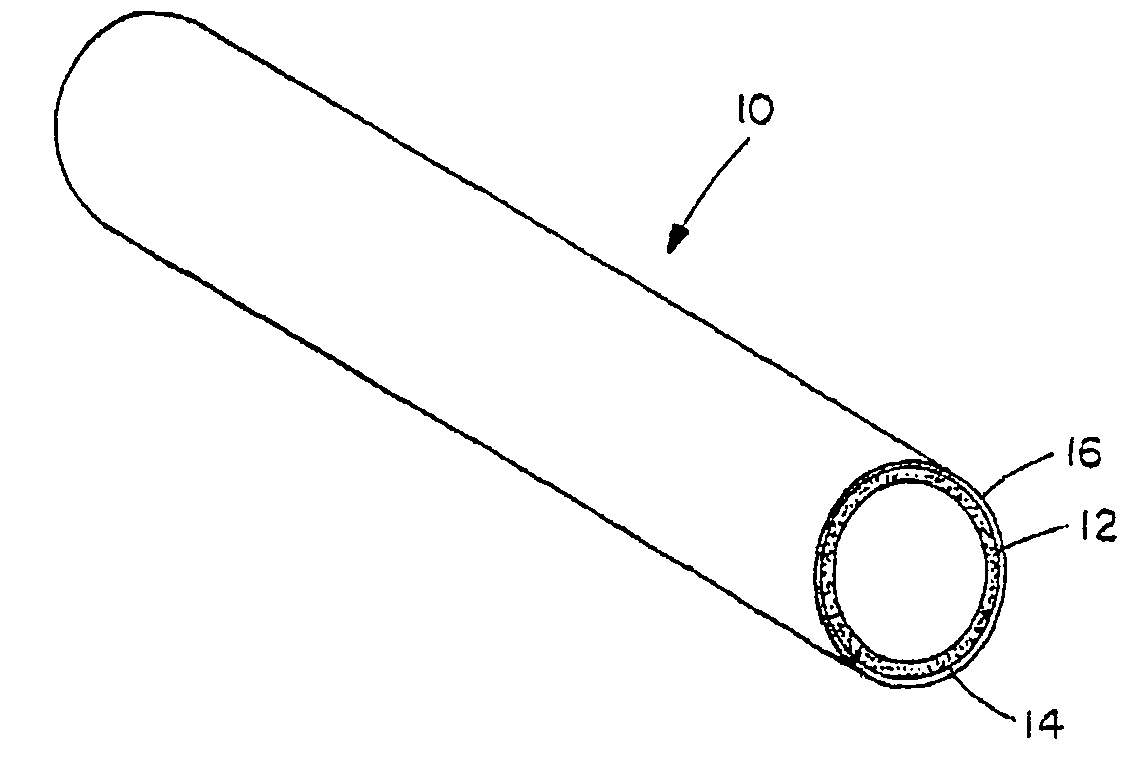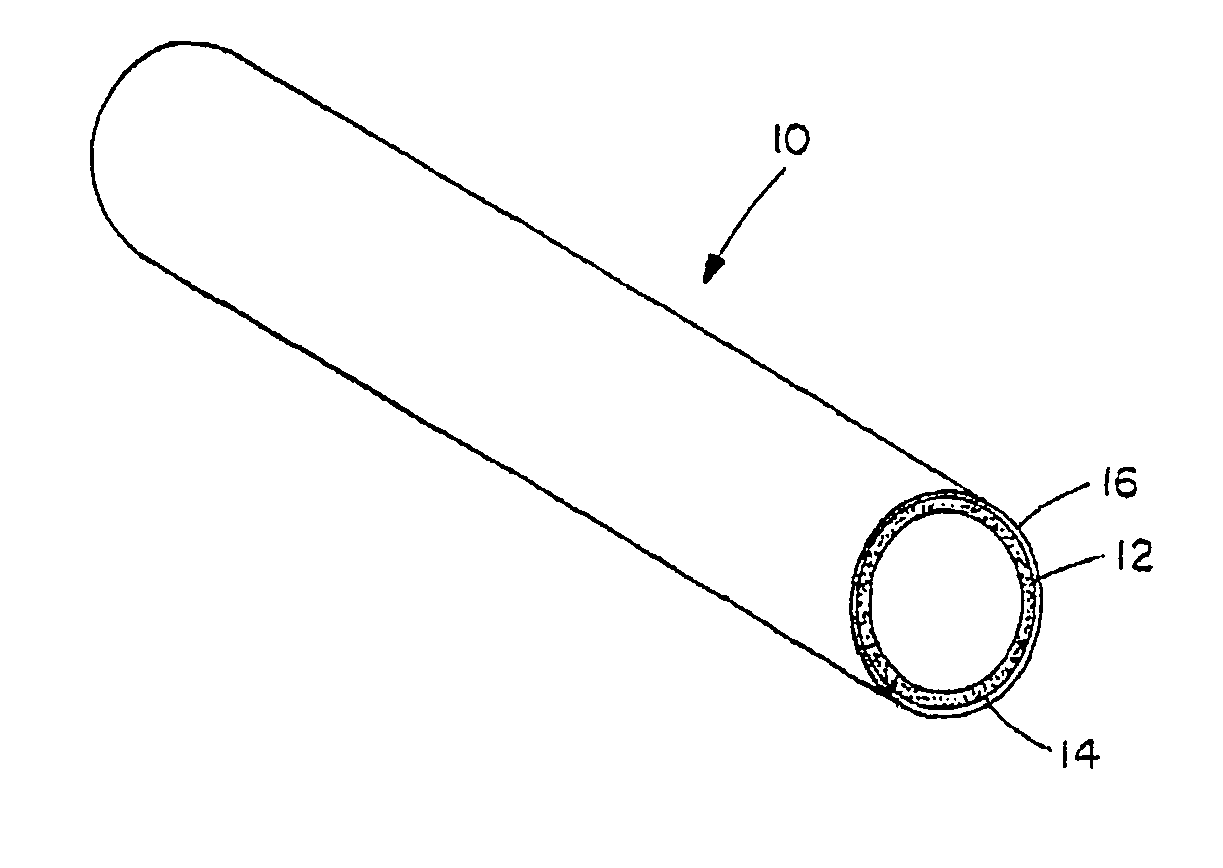Composite gas separation modules having high Tamman temperature intermediate layers
a gas separation module and high temperature technology, applied in the field of composite gas separation modules with high tamman, can solve the problems of reducing the hydrogen permeability of the membrane, reducing the effective life of the typical composite gas separation module having a hydrogen-selective metal membrane bonded to a porous substrate, and generally unsuitable polymer membranes, etc., to achieve the effect of preventing or reducing the diffusion of substrate components, reducing the pore size, and being economical
- Summary
- Abstract
- Description
- Claims
- Application Information
AI Technical Summary
Benefits of technology
Problems solved by technology
Method used
Image
Examples
example 1
[0101]This example describes the fabrication of a composite structure having a dense hydrogen-selective membrane, an intermediate layer that includes a tungsten powder, and a nominal 0.1 media grade porous 316L stainless steel (“PSS”) support.
[0102]A 6 inch (15.24 centimeter (cm)) long, 1 inch (2.54 cm) outside diameter (O.D.) section of PSS tube, welded to sections of 1 inch (2.54 cm) O.D. dense, non-porous 316L stainless steel tube on each end, was obtained from Mott Metallurgical Corporation. Contaminants were removed by cleaning the tube in an ultrasonic bath with alkaline solution at 60° C. for one half hour. The tube was then sequentially rinsed using tap water, deionized water and isopropanol. The tube was oxidized in static air at 400° C. for 12 hours wherein the rates of heating and cooling were 3° C. per minute.
[0103]A thin layer of tungsten powder was then applied to the outer surface of the PSS support by the following room temperature filtration operation. First, a slur...
example 2
[0119]This example describes the fabrication of a composite structure that includes a dense hydrogen-selective membrane, an intermediate layer that includes an aluminum oxide (Al2O3) powder, and a nominal 0.1 media grade porous HASTELLOY® C-22® support. (HASTELLOY® C-22® is a nickel-chromium-molybdenum-iron-tungsten alloy.)
[0120]A 6 inch (15.24 cm) long, 1 inch (2.54 cm) O.D. section of porous HASTELLOY® C-22® tube, welded to sections of 1 inch (2.54 cm) O.D. dense, non-porous 316L stainless steel tube on each end, was obtained from Mott Metallurgical Corporation. Contaminants were removed by cleaning the tube in an ultrasonic bath with alkaline solution at 60° C. for one half hour. The tube was then sequentially rinsed using tap water, deionized water and isopropanol. The tube was oxidized in static air at 700° C. for 12 hours. The rate of heating and cooling was 3° C. per minute.
[0121]A thin layer of Al2O3 powder was then applied to the outer surface of the support by the followin...
example 3
[0128]This example describes the fabrication of a composite structure that includes a dense hydrogen-selective membrane, an intermediate layer that includes a tungsten powder and silver powder, and a nominal 0.1 media grade porous HASTELLOY® C-22® support.
[0129]A 6 inch (15.24 cm) long, 1 inch (2.54 cm) O.D. section of porous HASTELLOY® C-22® tube, welded to sections of 1 inch (2.54 cm) O.D. dense, non-porous 316L stainless steel tube on each end, was obtained from Mott Metallurgical Corporation. Contaminants were removed by cleaning the tube in an ultrasonic bath with alkaline solution at 60° C. for one half hour. The tube was then sequentially rinsed using tap water, deionized water and isopropanol. The tube was oxidized in static air at 700° C. for 12 hours. The rate of heating and cooling was 3° C. per minute.
[0130]A thin layer of tungsten and silver was then applied to the outer surface of the support by the following room temperature filtration operation. First, a slurry of th...
PUM
| Property | Measurement | Unit |
|---|---|---|
| Thickness | aaaaa | aaaaa |
| Thickness | aaaaa | aaaaa |
| Thickness | aaaaa | aaaaa |
Abstract
Description
Claims
Application Information
 Login to View More
Login to View More - R&D
- Intellectual Property
- Life Sciences
- Materials
- Tech Scout
- Unparalleled Data Quality
- Higher Quality Content
- 60% Fewer Hallucinations
Browse by: Latest US Patents, China's latest patents, Technical Efficacy Thesaurus, Application Domain, Technology Topic, Popular Technical Reports.
© 2025 PatSnap. All rights reserved.Legal|Privacy policy|Modern Slavery Act Transparency Statement|Sitemap|About US| Contact US: help@patsnap.com


